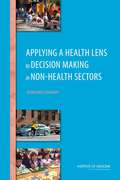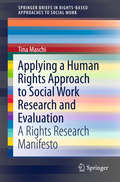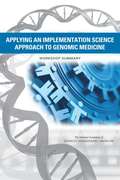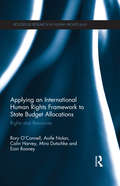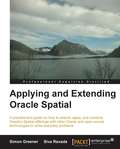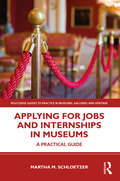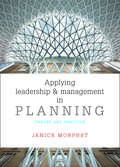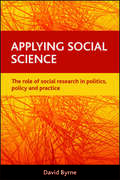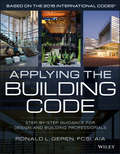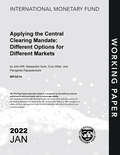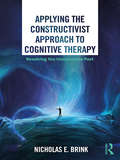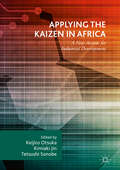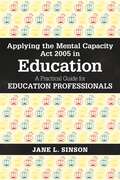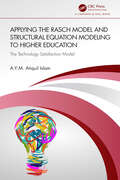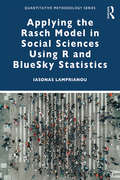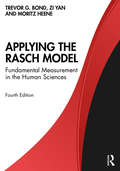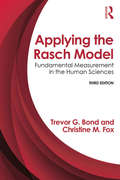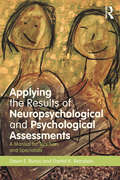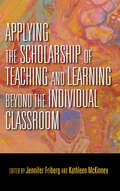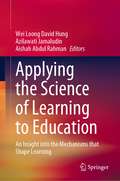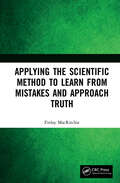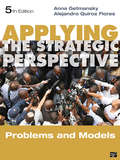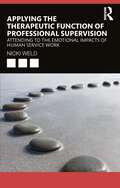- Table View
- List View
Applying a Health Lens to Decision Making in Non-Health Sectors: Workshop Summary
by Theresa WizemannHealth is influenced by a wide range of factors, many of which fall outside of the health care delivery sector. These determinants of health include, for example, the characteristics of how people live, work, learn, and play. Decision and policy making in areas such as transportation, housing, and education at different levels of government, and in the private sector, can have far-reaching impacts on health. Throughout the United States there has been increasing dialogue on incorporating a health perspective into policies, programs, and projects outside the health field. "Applying a Health Lens to Decision Making in Non-Health Sectors" is the summary of a workshop convened in September 2013 by the Institute of Medicine Roundtable on Population Health Improvement to foster cross-sectoral dialogue and consider the opportunities for and barriers to improving the conditions for health in the course of achieving other societal objectives (e. g. , economic development, efficient public transit). The roundtable engaged members, outside experts, and stakeholders on three core issues: supporting fruitful interaction between primary care and public health; strengthening governmental public health; and exploring community action in transforming the conditions that influence the public's health. This report is a discussion of health in all policies approaches to promote consideration for potential health effects in policy making in many relevant domains, such as education, transportation, and housing.
Applying a Human Rights Approach to Social Work Research and Evaluation: A Rights Research Manifesto (SpringerBriefs in Rights-Based Approaches to Social Work #0)
by Tina MaschiThis brief introduces a human rights approach to social work research and evaluation, compares it to traditional research approaches, and explains how to apply it in real world social work research. The author draws from a human rights framework that incorporates dignity and respect for all persons, the universality and interrelatedness of rights (political, civil, social, economic, and cultural), nondiscrimination, participation, accountability, and transparency. To advance a human rights approach, it introduces a rights-based model that accentuates the use of mixed methods and participatory research and evaluation. This brief aims to increase competencies in how to apply a rights based approach to research decision-making process from the formulation of research questions, research and practice design, and participatory action strategies that advance human rights. It is a call to action for social workers to forge a rights-based research agenda that fosters empowerment.
Applying a Systems Thinking Approach to the Construction Industry
by Michael SiebertThis book aims to shed light on why it is that so many well-meaning initiatives and government white papers have failed to have the expected impact in transforming the UK construction industry. Using the UK housing sector as a case study, Mike Siebert applies a Systems Thinking approach to tackling some of the shared 'Wicked Problems' faced by an industry that urgently needs to boost its productivity levels, build more sustainably and affordably, and generally improve its working practices. In an accessible and easy to read style, Siebert challenges the overall decision making and problem-solving approach adopted by the industry and seeks to put Systems Thinking front and centre to consider the core issues from multiple perspectives. Initially outlining the key stakeholders and the drivers and barriers to change, he then introduces Systems Thinking and explains using numerous examples of known issues what this approach could achieve. His central aim is to show how, if a Systems Thinking approach were to be applied to the UK housing industry’s problems, many of them could be resolved to the benefit of all the parties involved – government, housebuilders, material suppliers, the warranty industry, the design industry and the end users. These are shared problems, and they require shared solutions, but without first understanding these complex problems from the perspectives of all parties that need to benefit from the solutions being proposed, it is unlikely that those solutions will achieve the level of engagement needed for them to successfully meet their objectives.
Applying an Implementation Science Approach to Genomic Medicine: Workshop Summary
by Engineering Medicine National Academies of SciencesAlthough it is becoming increasingly more common for clinicians to use genomic data in their practices for disease prevention, diagnosis, and treatment, the process of integrating genomic data into the practice of medicine has been a slow and challenging one. Some of the major barriers impeding the incorporation of new genomic technology into clinical practice are: the difficulty of changing routine medical practices to account for the use of genetic testing, the limited knowledge of patients and providers about genomic medicine, assessing sufficient evidence to support the use of genetic tests, privacy and data security issues, and uncertainty about reimbursement. The field of implementation science may be able to provide insights concerning efficient ways to incorporate genomic applications into routine clinical practice. The focus of implementation science studies is to identify integration bottlenecks and optimal approaches for a given setting and ultimately to promote the up-take of research findings. To explore the potential of implementation science to improve the integration of genomics into medicine, the National Academies of Sciences, Engineering, and Medicine held a workshop in Washington, DC, in November 2015. Participants explored the challenges and opportunities of integrating genomic advances into the clinic through the lens of implementation science. This report summarizes the presentations and discussions from the workshop.
Applying an International Human Rights Framework to State Budget Allocations: Rights and Resources (Routledge Research in Human Rights Law)
by Colin Harvey Aoife Nolan Rory O'Connell Mira Dutschke Eoin RooneyHuman rights based budget analysis projects have emerged at a time when the United Nations has asserted the indivisibility of all human rights and attention is increasingly focused on the role of non-judicial bodies in promoting and protecting human rights. This book seeks to develop the human rights framework for such budget analyses, by exploring the international law obligations of the International Covenant on Economic, Social and Cultural Rights (ICESCR) in relation to budgetary processes. The book outlines international experiences and comparative practice in relation to economic and social rights budget analysis and budgeting. The book sets out an ICESCR-based methodology for analysing budget and resource allocations and focuses on the legal obligation imposed on state parties by article 2(1) of ICESCR to progressively realise economic and social rights to 'the maximum of available resources'. Taking Northern Ireland as a key case study, the book demonstrates and promotes the use of a ‘rights-based’ approach in budgetary decision-making. The book will be relevant to a global audience currently considering how to engage in the budget process from a human rights perspective. It will be of interest to students and researchers of international human rights law and public law, as well as economic and social rights advocacy and lobbying groups.
Applying and Extending Oracle Spatial
by Siva Ravada Simon GreenerThis book is an advanced practical guide to applying and extending Oracle Spatial.This book is for existing users of Oracle and Oracle Spatial who have, at a minimum, basic operational experience of using Oracle or an equivalent database. Advanced skills are not required.
Applying for Jobs and Internships in Museums: A Practical Guide (Routledge Guides to Practice in Museums, Galleries and Heritage)
by Martha M. SchloetzerApplying for Jobs and Internships in Museums offers a straightforward approach to applying for positions within a museum. Martha M. Schloetzer provides practical advice about the application and interview process that will prepare emerging museum professionals as they approach the profession. From reviewing job and internship postings to developing a solid resume and writing distinctive cover letters, this guide provides practical, sound advice for museum job seekers. Schloetzer integrates the stories of successful and unsuccessful interns and job applicants throughout the book’s narrative, and recognizing the additional challenges faced by non-US nationals, the book also offers information specifically for international students seeking work experience in US museums. The insider information included in Applying for Jobs and Internships in Museums makes it a key resource for both a US and international audience interested in gaining museum experience in the US. It will be of particular interest to college-level and graduate school students, as well as recent graduates. The guide can also serve as a reference in the classroom, helping professors and instructors prepare students for the job search ahead.
Applying leadership and management in planning: Theory and Practice
by Janice MorphetPlanning is central to economic, social and environmental life but its practice is frequently criticised by all who engage in it. Seen as too restrictive by those who promote development and too weak by those opposing it, planners who advise on proposals cannot sit on the fence. Is it the planning system that is problematic or is it the planners who work within it? This valuable book examines these issues at the continuing professional development level and discusses the ways in which management theories, tools and techniques can be applied to planning practice and used by all who engage in it. Written by an experienced author and widely respected academic, the book includes case studies and question and answer sections, and will be valuable through both initial and continuous professional education, helping candidates prepare for examinations and subsequent management.
Applying social science: The role of social research in politics, policy and practice
by David ByrneIn complex contemporary societies social science has become increasingly interwoven into the whole fabric of governance. At the same time there is an increasing recognition that attempts to understand the social world which seek to mimic the linear approaches of the conventional 'hard sciences' are mostly useless given the complex systems character of society in all its aspects. This book draws on a synthesis of critical realism and complexity theory to examine how social science is applied now and how it might be applied in the future in relation to social transformation in a time of crisis. A central argument is that there is no such thing as a 'pure' science of the social and that a recognition of the inevitability of application imposes obligations on social scientists wherever they work which challenge the passivity of most in the face of inequality and injustice.
Applying the ADA
by Marcela A. RhoadsA guide to real-world applications of The 2010 Americans with Disabilities Act Standards for Accessible DesignApplying the ADA helps architects and developers understand better how the rules for eliminating barriers in the built environment apply to everyday life and how to best implement them in the design and construction of a broad variety of buildings and facilities.By showing how The 2010 Americans with Disabilities Act Standards for Accessible Design have been applied in various contexts and building types, this extensively illustrated guide helps readers quickly understand the requirements of the standards and how to apply them to both new construction and renovation. Written by an architect who consults regularly on accessibility issues for design professionals, building owners, and facility managers, this user-friendly guide features 100 photos and 150 drawings that take the guesswork out of applying the standards to real-world projects. Building types covered include:Healthcare and senior living facilities and hospitalsCollege and university facilitiesElementary and high schoolsHotels and other transient lodging facilitiesAmusement parks and play areasHistoric preservation and remodelsRetail and office spacesApplying the ADA is an indispensable resource for architects, interior designers, owners, developers, and facility managers. It is also important reading for students of architecture and interior design.
Applying the Building Code
by Ronald L. GerenNo other resource--not even the building code--presents the exact code information you need, when you need it at design stage The International Building Code (IBC) is a model building code developed by the International Code Council (ICC). The IBC and its complementary codes provide design and construction professionals with a complete set of comprehensive, coordinated building safety and fire prevention regulations in order to safeguard the public health and general welfare of the occupants of new and existing buildings and structures. Adopted throughout most of the United States and its territories, it is referenced by federal agencies, such as the General Services Administration, National Park Service, Department of State, U.S. Forest Service, and the Department of Defense. For architects and other design and construction professionals, it is particularly important that they understand how to apply the IBC and how code officials view buildings, so that they integrate code-required provisions in the earliest design stages of any project. Applying the IBC, as well as its companion codes, to building design is a process that is uniquely different to that of applying the building code during a planning review. Whereas other guide books explain the IBC in sequential order, from cover to cover, chapter by chapter, and section by section, Applying the Building Code explains the requirements of the IBC as they would apply during the common phases of design: from schematic design through to the preparation of construction documents. This effectively highlights applicable requirements of the building code at the appropriate stage of design based on available information. The book provides a 28-step process that is organized according to the three phases of architectural design: schematic design, design development, and construction documents Each step explains the application of the IBC, as well as other codes and standards referenced by the IBC (i.e. International Fire Code, International Energy Conservation Code, and ANSI A117.1) based on available project information Illustrations and examples are provided throughout that explain the code fundamentals associated with each step A single example project is used throughout the step-by-step process to illustrate how each step is applied and builds upon code and project information obtained through previous steps Guidance is also provided on the International Existing Building Code and how the step-by-step process is applied to projects involving existing buildings The role of the building department and its staff in regard to plan reviews and code enforcement is discussed A detailed code data information template is provided that can help organize code-related information for construction documents
Applying the Central Clearing Mandate: Different Options for Different Markets (Imf Working Papers)
by John Kiff, Alessandro Gullo, Cory Hillier, and Panagiotis PapapaschalisA report from the International Monetary Fund.
Applying the Constructivist Approach to Cognitive Therapy: Resolving the Unconscious Past
by Nicholas E. BrinkApplying the Constructivist Approach to Cognitive Therapy goes beyond the traditional objectivist approach of uncovering the what of a client’s dysfunctional thinking by helping client and therapist understand why the client thinks in a dysfunctional manner. This unique work demonstrates how this thinking can be uncovered through dreamwork, analytic hypnotherapy, ecstatic trance, and other spontaneous trance experiences such as the use of imagination, free association, and guided imagery. Utilizing hypnotherapeutic techniques, the author shows how clients can reframe these thoughts to achieve a healthier, more functional way of thinking. Replete with case studies and practical guidance, this text will help therapists take clients beyond a simple resolution of their problems and offer an avenue to greater personal growth, maturity, and creativity.
Applying the Kaizen in Africa: A New Avenue for Industrial Development
by Keijiro Otsuka Tetsushi Sonobe Kimiaki JinAt present, how to develop industries is a burning issue in Africa, where population growth remains high and economic development has thus far failed to provide sufficient jobs for many, especially young people and women. The creation of productive jobs through industrial development ought to be a central issue in steering economic activity across the continent.The authors of this book, consisting of two development economists and five practitioners, argue that the adoption of Kaizen management practices, which originated in Japan and have become widely used by manufacturers in advanced and emerging economies, is decisively the most effective first step for industrial development in Africa.This open access book discusses what Kaizen management is, why it is applicable to Africa, and why it can provide Africa with a springboard for sustainable economic growth and employment generation.
Applying the Mental Capacity Act 2005 in Education: A Practical Guide for Education Professionals
by Jane L. SinsonThis straightforward book explains the introduction of the Mental Capacity Act 2005 (MCA) and its code of practice (COP) as part of the Children and Families Act 2014 and the accompanying SEND COP in England. This is the first comprehensive book to explain to education professionals the legal requirement to follow the MCA COP and SEND COP guidelines when formally considering a young person's (16 - 25) capacity to make decisions about their education. Using education-focussed case studies throughout to illustrate key points, this practical guide explains the MCA five principles, defines the term 'mental capacity' and clarifies the circumstances in which a young person would lack capacity to make a decision. It describes when a capacity assessment is likely to be required and presents a step-by-step guide to undertaking a capacity assessment. This is the essential guide to the MCA for FE college tutors, post 16 teachers, specialist teachers, local authority SEN officers and educational psychologists.
Applying the Rasch Model and Structural Equation Modeling to Higher Education: The Technology Satisfaction Model
by A.Y.M. Atiquil IslamThis book introduces the fundamentals of the technology satisfaction model (TSM), supporting readers in applying the Rasch model and structural equation modeling (SEM) – a multivariate technique – to higher education (HE) research. User satisfaction is traditionally measured along a single dimension. However, the TSM includes digital technologies for teaching, learning and research across three dimensions: computer efficacy, perceived ease of use and perceived usefulness. Establishing relationships among these factors is a challenge. Although commonly used in psychology to trace relationships, Rasch and SEM approaches are rarely used in educational technology or library and information science. This book, therefore, shows that combining these two analytical tools offers researchers better options for measurement and generalisation in HE research. This title presents theoretical and methodological insights of use to researchers in HE.
Applying the Rasch Model in Social Sciences Using R (Quantitative Methodology Series)
by Iasonas LamprianouThis unique text provides a step-by-step beginner’s guide to applying the Rasch model in R, a probabilistic model used by researchers across the social sciences to measure unobservable ("latent") variables. Each chapter is devoted to one popular Rasch model, ranging from the least to the most complex. Through a freely available and user-friendly package, BlueSky Statistics, Lamprianou offers a range of options for presenting results, critically examines the strengths and weaknesses of applying the Rasch model in each instance, and suggests more effective methodologies where applicable. With a focus on simple software code which does not assume extensive mathematical knowledge, the reader is initially introduced to the so-called simple Rasch Model to construct a "political activism" variable out of a group of dichotomously scored questions. In subsequent chapters, the book covers everything from the Rating Scale to the Many-facets Rasch model. The final chapter even showcases a complete mock manuscript, demonstrating how a Rasch-based paper on the identification of online hate speech should look like. Combining theoretical rigor and real-world examples with empirical datasets from published papers, this book is essential reading for students and researchers alike who aspire to use Rasch models in their research.
Applying the Rasch Model: Fundamental Measurement in the Human Sciences
by Trevor Bond Zi Yan Moritz HeeneRecognised as the most influential publication in the field, ARM facilitates deep understanding of the Rasch model and its practical applications. The authors review the crucial properties of the model and demonstrate its use with examples across the human sciences. Readers will be able to understand and critically evaluate Rasch measurement research, perform their own Rasch analyses and interpret their results. The glossary and illustrations support that understanding, and the accessible approach means that it is ideal for readers without a mathematical background. Highlights of the new edition include: More learning tools to strengthen readers’ understanding including chapter introductions, boldfaced key terms, chapter summaries, activities and suggested readings. Greater emphasis on the use of R packages; readers can download the R code from the Routledge website. Explores the distinction between numerical values, quantity and units, to understand the measurement and the role of the Rasch logit scale (Chapter 4). A new four-option data set from the IASQ (Instrumental Attitude towards Self-assessment Questionnaire) for the Rating Scale Model (RSM) analysis exemplar (Chapter 6). Clarifies the relationship between Rasch measurement, path analysis and SEM, with a host of new examples of Rasch measurement applied across health sciences, education and psychology (Chapter 10). Intended as a text for graduate courses in measurement, item response theory, (advanced) research methods or quantitative analysis taught in psychology, education, human development, business, and other social and health sciences. Professionals in these areas will also appreciate the book’s accessible introduction.
Applying the Rasch Model: Fundamental Measurement in the Human Sciences, Third Edition
by Trevor Bond Christine M. FoxCited over 1900 times, this classic text facilitates a deep understanding of the Rasch model. The authors review the crucial properties of the model and demonstrate its use with a variety of examples from education, psychology, and health. A glossary and numerous illustrations aid the reader's understanding. Readers learn how to apply Rasch analysis so they can perform their own analyses and interpret the results. The authors present an accessible overview that does not require a mathematical background. Highlights of the new edition include: -More learning tools to strengthen readers’ understanding including chapter introductions, boldfaced key terms, chapter summaries, activities, and suggested readings. -Divided chapters (4, 6, 7 & 8) into basic and extended understanding sections so readers can select the level most appropriate for their needs and to provide more in-depth investigations of key topics. -A website at www.routledge.com/9780415833424 that features free Rasch software, data sets, an Invariance worksheet, detailed instructions for key analyses, and links to related sources. -Greater emphasis on the role of Rasch measurement as a priori in the construction of scales and its use post hoc to reveal the extent to which interval scale measurement is instantiated in existing data sets. -Emphasizes the importance of interval level measurement data and demonstrates how Rasch measurement is used to examine measurement invariance. -Insights from other Rasch scholars via innovative applications (Ch. 9). -Extended discussion of invariance now reviews DIF, DPF, and anchoring (ch. 5). -Revised Rating Scale Model material now based on the analysis of the CEAQ (ch.6). -Clarifies the relationships between Rasch measurement, True Score Theory, and Item Response Theory by reviewing their commonalities and differences (Ch.13). -Provides more detail on how to conduct a Rasch analysis so readers can use the techniques on their own (Appendix B). Intended as a text for graduate courses in measurement, item response theory, (advanced) research methods or quantitative analysis taught in psychology, education, human development, business, and other social and health sciences, professionals in these areas also appreciate the book‘s accessible introduction.
Applying the Results of Neuropsychological and Psychological Assessments: A Manual for Teachers and Specialists
by Dawn E. Burau Daniel K. ReinsteinNeuropsychological and psychological evaluations in school settings are often rich in detail about a child’s cognitive, academic and emotional functions, and come with specific recommendations to support the child’s performance in school. However, there is often a gap between the assessment results and the implementation of the recommendations, since learning specialists and teachers frequently do not have the means to both interpret and implement the recommendations. This manual presents clear and specific guidelines for school counselors and teachers to decode and put into practice evaluation findings. The book begins by describing various functional domains that are assessed in a neuropsychological evaluation, and then notes how to recognize behavior and learning styles impacted by difficulty in one of more of the domains. Furthermore, it outlines activities that could be used in the classroom or other environments to support a child’s weaknesses, develop new skills, or appear to particular strengths. Finally, ready-to-use worksheets and activities are offered. This is an essential tool for school psychologists, special education teachers, and learning specialists and counselors.
Applying the Scholarship of Teaching and Learning beyond the Individual Classroom (Scholarship of Teaching and Learning)
by Edited by Jennifer Friberg and Kathleen McKinneyA survey of exemplary SoTL research projects and the use of their results on a broader scale.When the Scholarship of Teaching and Learning (SoTL) emerged, it often concentrated on individual faculty practice in one classroom; it is now, however, increasingly common to find work in SoTL focused more broadly. SoTL studies may engage with a cluster of courses, a program, a particular population of students, a pedagogical approach, or a field—all of which are represented in the essays collected here by authors from a diverse array of institutions and nations. This volume features examples of SoTL research conducted in, and applied to, a variety of contexts and disciplines, offering a theoretical framework for an expanded vision of SoTL—one that moves beyond the individual classroom.
Applying the Science of Learning to Education: An Insight into the Mechanisms that Shape Learning
by Azilawati Jamaludin Wei Loong David Hung Aishah Abdul RahmanThis book provides an overview of the various 'Science of Learning' (SoL) research projects led by researchers at the National Institute of Education, Nanyang Technological University, Singapore, and international research collaborators. It presents the goals and rationale behind the Science of Learning in Education (SoLE) initiative and examines a spectrum of topics relevant to bolstering our understanding of the science underlying learning. The Science of Learning (SoL) is an advancing field, with proponents extolling its potential impact on educational practice. This book investigates the possible correlations or causal relationships between brain functioning and development, physiology, environment factors, and their impact on learning. It promotes an interdisciplinary approach to understanding biological to behavioural mechanisms of learning that are oriented toward optimizing and maximizing every learner’s potential.
Applying the Scientific Method to Learn from Mistakes and Approach Truth
by Finlay MacRitchieIn its simplest form, the scientific method can be thought of as learning from our mistakes and trying to correct them. True scientists try to think rationally, never adopt dogmatic opinions and are always willing to listen to opposing views. They never claim to know the absolute truth but are relentless in their search for it. In this timely book, the author describes the fundamentals of critical scientific thinking. The book further examines the correct use of the scientific method and how to apply it to current events and scientific topics to obtain honest assessments. Current controversies discussed include climate change and COVID-related lockdowns.Additional Features include: Demonstrates the use of the scientific method to assist with objective analysis of issues Addresses that induction plays a role but the true method for advancing knowledge is hypothesis-deduction Explores current hot topics within the framework of the scientific method Outlines common misunderstandings of the scientific method Applying the Scientific Method to Learn from Mistakes and Approach Truth is approachable enough for the general public and recommended for university and advanced high school science educators and their students.
Applying the Strategic Perspective: Problems and Models, Workbook
by Anna Getmansky Alejandro Quiroz FloresFully revised and reorganized by Anna Getmansky and Alejandro Quiroz Flores to fit the exciting new edition of Bruce Bueno de Mesquita's Principles of International Politics, this accompanying workbook continues to feature class-tested, user-friendly exercises that walk students through the building blocks of the strategic method, ensuring that even novice students have the opportunity to develop and hone their problem-solving skills and can successfully apply what they have learned in the text. The fifth edition of Applying the Strategic Perspective: Problems and Models, Workbook introduces students to a wide range of problems so that they master basic principles as well as test their capabilities with more challenging material. Easy for students to use, and with perforated pages for turning in assignments.
Applying the Therapeutic Function of Professional Supervision: Attending to the Emotional Impacts of Human Service Work
by Nicki WeldThis book brings a fresh approach and conversation to the practice of professional supervision for human services by specifically articulating its often performed, but unnamed and under-explored therapeutic function. The discussion of the therapeutic function is timely given the rising complexities in our world, and the increasing awareness of emotional impacts of human service work. These impacts include stress, distress, emotional labour, indirect trauma, and direct trauma. Posing a challenge and invitation to supervisors to comfortably inhabit the therapeutic function of supervision to increase emotional support to workers, it places safe practice and worker wellbeing at the heart of supervision to enable high quality service delivery for often the most vulnerable in society. While underpinned by theory, it is written to be practically applied and is developed from a ‘lived experience’ perspective, offering a unique glimpse into actual practice. By modelling one of the main aims of professional supervision, which is to facilitate and enable the integration of experience into learning and knowledge, it will be of interest to all practitioners across a broad range of human services, particularly both new and experienced supervisors.
